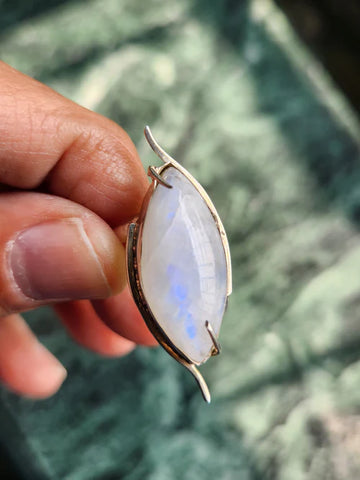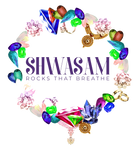Moonstone and Rainbow Moonstone are often considered to be the same mineral, making it challenging for non-experts to differentiate between them. This blog aims to clarify the confusion surrounding these two minerals, which are often speculated to be identical due to their similar names. Are they truly the same stone, or are there significant differences? This blog will delve into these questions to provide a clearer understanding of both gemstones.

Moonstone
Moonstone a member of the feldspar group, typically displays a milky or opaque base and is known for its adularescence a phenomenon that creates a floating blue to white sheen. The color range of moonstone spans from colorless to shades of grey, white, pink, peach, yellow and green. Its shimmer, which can also include blue or multicolored reflections, contributes to its allure and is especially visible in stones with lighter body colors.

Rainbow Moonstone
Rainbow moonstone is not a variety of moonstone but rather a trade name for a different feldspar mineral known as labradorite which displays a strong multicolored adularescence. The base color of rainbow moonstone is typically a light to dark grey, and its iridescence can include a spectrum of colors such as vivid blues, greens and a range of pastel hues. This phenomenon is due to light diffraction within the layers of the mineral resulting in a dynamic play of colors akin to a rainbow.

Geographical Origins
Moonstones leads you to several key locales. Sri Lanka, historically known as Ceylon, is renowned for its high-quality moonstones, aptly named Ceylon moonstones. These moonstones are prized for their blue sheen and translucent body. In India, moonstones are also found with a more subdued appearance but are deeply valued in the local gem market. Venturing to Madagascar, you'll find moonstones that are similar in quality to those from Sri Lanka, with their own unique beauty. The United States, specifically in states like New Mexico, produces moonstones as well, albeit lesser known than their Asian counterparts.

Rainbow moonstone mainly found in Australia, Brazil and Myanmar also contribute to the market but to lesser extents. Each region contributes to the broad spectrum of qualities seen in rainbow moonstones, from transparent to opaque, reflecting the diverse geological conditions where they form.

Energetic Influences
Moonstone is often associated with enhancing intuition and stabilizing emotions. As a gemstone deeply connected to the crown chakra, it is believed to foster spiritual connection and psychic awareness.
- Intuitive Clarity: Believed to clarify intuition, helping you understand your own emotions more clearly.
- Emotional Balance: Supports the achievement of balance in emotional states, promoting a sense of peace.

Rainbow Moonstone with its play of colors, is said to invoke divine feminine energy. It shares similar properties with moonstone but emphasizes the variety and spectrum of those energetic qualities.
- Feminine Energy: Helps in channeling and amplifying feminine energy, which is often associated with fertility and nurturing.
- Spirituality and Peace: Shown to enhance spiritual growth and inner peace. It's celebrated during the full moon for heightened metaphysical properties.

Cultural Significance
Moonstone and rainbow moonstone carry profound cultural significance across various civilizations, revered not just for their beauty but for their metaphysical properties.
- Peace and Harmony: Culturally, moonstones have been symbols of peace and tranquility.
- Spirituality: These stones are frequently used in spiritual ceremonies to invoke higher consciousness and psychic abilities.

Rainbow Moonstone, with its luminous sheen and spectral light, is often seen as a connection to the mystical and the divine.
- Fertility: It's historically been linked to fertility and the cycles of life, from ancient goddess worship to contemporary spiritual practices.
- Connection with the Divine: Beyond personal spirituality, rainbow moonstone is believed to bridge earthly life with the ineffable.

Cutting and Shaping
Cutting and shaping are crucial in distinguishing between Moonstone and Rainbow Moonstone. Faceted gemstones reveal unique characteristics that differentiate these varieties, aiding identification with clarity and precision in gemstone appreciation and selection. Moonstones are typically cut into cabochons, a process that best accentuates their adularescence the glowing sheen across the surface. A well-executed cabochon cut enhances the visibility of phenomena such as asterism or the cat's eye effect in high-quality specimens. Rainbow moonstone, a trade name for a type of labradorite with a multicolored sheen, is also given a similar treatment to showcase its unique color play.
Popular Types of Jewelry
- Engagement Rings: Both moonstone and rainbow moonstone are becoming increasingly popular in engagement rings due to their unique appearance and symbolism.
- Pendants and Necklaces: The soft glow of these gemstones makes them ideal for pendants that catch the light.
- Earrings and Bracelets: Their versatility extends to earrings and bracelets, adding a subtle elegance.
Moonstone jewelry is appreciated not just for its beauty but also for its perceived spiritual significance it associated with love, fertility and intuition.
Popularity
If we talk about popularity, both Moonstone and Rainbow Moonstone are highly sought after due to their unique colors, appearance, and symbolic meanings. These gemstones are particularly beloved by women, with Rainbow Moonstone often adorning engagement rings, while Moonstone is favored for home decor items like carvings, free forms, and tumbles.
In the realm of jewelry, Rainbow Moonstone enjoys a robust market presence with a wide variety of designs and styles available. Its iridescence and play of colors make it a captivating choice for statement pieces. Moonstone, although slightly less prevalent in jewelry, finds its niche primarily in decorative items for the home. Its milky white sheen and subtle blue adularescence lend an ethereal quality to any setting. Both Moonstone and Rainbow Moonstone continue to captivate enthusiasts and collectors alike, offering a blend of aesthetic appeal and spiritual significance that transcends trends and fads.
Determining Value and Price
Moonstones and rainbow moonstones have a layered composition of feldspar minerals that diffract light, creating an enchanting visual effect known as adularescence. This optical phenomenon primarily influences their appeal and, subsequently, their market value. Unlike moonstones, which display a serene white to blue sheen, rainbow moonstones exhibit a prism of colors, akin to opalite, but are entirely natural in their charisma.

Prices for these gemstones are pegged on rarity and quality, with the top-tier rainbow moonstones in sizes over 10 carats fetching higher sums due to their scarcity and striking color play. Finest rainbow moonstones in scarce large carat sizes have been known to command prices as high as fine blue sheen moonstones, an aspect that speaks to the premium that collectors and connoisseurs are willing to pay for exceptional pieces.
Factors such as clarity, cut quality, and origin also play critical roles. Inclusions can deter from the gem's beauty and reduce its price, but some consumers appreciate the unique 'flaws' for their character and personality. A well-executed cut that maximizes the adularescence can amplify the gemstone's allure boosting its market price.

Moonstones and especially fine quality rainbow moonstones can be more expensive than alternatives like polymer clay creations or opalite, a man-made glass that imitates the color play of precious stones but lacks their natural beauty and durability. The natural allure, durability, and rarity of real moonstones and rainbow moonstones often justify their higher prices in the jewelry market.
Hope this information is helpful for you. Now you can easily choose between Moonstone or Rainbow Moonstone for your upcoming festival purchase.
 USD
USD EUR
EUR
 AUD
AUD
 GBP
GBP
 INR
INR


